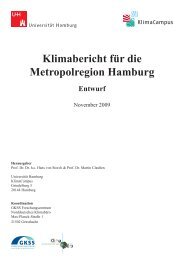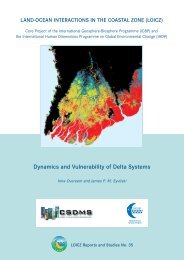ABAQUS user subroutines for the simulation of viscoplastic - loicz
ABAQUS user subroutines for the simulation of viscoplastic - loicz
ABAQUS user subroutines for the simulation of viscoplastic - loicz
Create successful ePaper yourself
Turn your PDF publications into a flip-book with our unique Google optimized e-Paper software.
5. User material routines and <strong>the</strong>ir applications<br />
The material models mentioned above are implemented into <strong>the</strong> commercial FE code <strong>ABAQUS</strong><br />
as <strong>user</strong>-defined material model by writing <strong>the</strong> corresponding <strong>user</strong> <strong>subroutines</strong>, UMAT, see Table 1.<br />
With help <strong>of</strong> <strong>the</strong>se UMATs one can apply <strong>the</strong> models in an FE analysis <strong>of</strong> <strong>viscoplastic</strong> damage<br />
behaviour <strong>of</strong> engineering components and structures. All <strong>the</strong> routines are written in <strong>the</strong> computer<br />
language FORTRAN using <strong>the</strong> <strong>for</strong>ward integration algorithm <strong>for</strong> numerical integration. Only iso<strong>the</strong>rmal<br />
loading conditions have been considered and <strong>the</strong> damage deactivation has not been included in any <strong>of</strong><br />
<strong>the</strong> routines. Viscoplastic FE calculations are very time consuming. In <strong>the</strong> routines however, no<br />
automatic time step control is used, so that <strong>the</strong>re is a necessity to improve <strong>the</strong> respective algorithms. All<br />
examples presented below are conducted using <strong>ABAQUS</strong>/Standard 5.8.<br />
model UMAT<br />
CHABOCHE model coupled with damage d-chaboche.f<br />
BODNER-PARTOM model coupled with damage d-bodner.f<br />
anisotropic creep and damage model <strong>of</strong> BERTRAM,<br />
OLSCHEWSKI & QI<br />
d-scsrr99.f<br />
Table 1: Constitutive models and names <strong>of</strong> <strong>the</strong> respecitve UMATs<br />
5.1 Circumferentially notched bar — CHABOCHE model coupled with damage<br />
The material parameters <strong>of</strong> <strong>the</strong> CHABOCHE model <strong>of</strong> IN 738 LC have been determined by<br />
OLSCHEWSKI et al. [1990] and <strong>the</strong>ir values at 850 °C are shown in Table 2. The material parameters <strong>of</strong><br />
<strong>the</strong> damage model were estimated by using numerical optimization methods to fit <strong>the</strong> creep data <strong>of</strong> <strong>the</strong><br />
three creep tests presented in <strong>the</strong> work <strong>of</strong> OLSCHEWSKI et al. [1990]. During this process <strong>the</strong> above<br />
values <strong>of</strong> <strong>the</strong> parameters <strong>of</strong> <strong>the</strong> CHABOCHE model were kept constant. Table 3 shows a set <strong>of</strong> damage<br />
parameters <strong>for</strong> IN 738 LC at 850 °C. Note that just three uniaxial tests are not sufficient <strong>for</strong> parameter<br />
identification, so that <strong>the</strong> values given in Table 3 are only first estimates. For lack <strong>of</strong> biaxial test data, <strong>the</strong><br />
anisotropy parameter β can not be determined. Comparison <strong>of</strong> <strong>the</strong> experiments and <strong>the</strong> predictions by<br />
<strong>the</strong> CHABOCHE model and by <strong>the</strong> coupled model with damage, respectively, using <strong>the</strong> material<br />
17





